Epikarst Flow Dynamics and Contaminant Attenuation: Field and Laboratory Insights from the Suva Planina Karst System
Abstract
1. Introduction
2. Characteristics of the Study Area
3. Materials and Methods
4. Results and Discussion
4.1. The Artificial Tracer Experiment
- Group 1 (H, I, L): Tracer appeared in initial samples. The highest concentration (0.17 μg/L) was recorded at H at 4:00 PM. At H, levels declined steadily and vanished by 9:00 AM the next day. At I, three pulses were observed, with concentrations increasing from 0.08 to 0.14 μg/L. At all tracer-positive sites, detection ceased within 21 h.
- Group 2 (C, D, F): Near the cave entrance, tracer was detected immediately. The highest concentration occurred at D. Tracer was undetectable at C and F after 8:00 PM, and at D after 9:00 AM the next day.
- Group 3 (A, B, G, M): Characterized by minimal inflow and fewer samples. The tracer was detected only at A (0.15 μg/L) in the first sample.
- A branched conduit network, possibly including siphon segments, where water with tracer is temporarily retained until displaced by subsequent flow.
- Partial adsorption of the tracer to soil particles (Terra Rossa) or clay minerals, followed by desorption when clean water flushes the system [43].
4.2. The Experiment with Contaminants
- SP1—near the entrance (location C during tracer test);
- SP2—mid-cave (location H during tracer test);
- SP3—furthest from the entrance (location L during tracer test).
- 10 L of manure-well water slurry—SP K;
- 10 kg of solid manure (rinsed with well water);
- Additional 20 L of contaminated well water to aid infiltration—SP D.
- First wave due to initial snowmelt and rain,
- Second due to rainfall intensification,
- SP1 and SP3, at different times. At SP1 (farthest from the contamination site), bacteria appeared only after prolonged rainfall and snowmelt, indicating delayed transport due to system saturation and flushing.
- SP2 had a smaller peak (6 cfu), with three bacterial waves (1 < 3 < 4 cfu), corresponding to water pulses.
- SP3 (closest to the contamination point) showed the fastest bacterial response, followed by lower but persistent bacterial presence even in later samples.
- Ammonia (initially 1.5–1.75 mg/L) was never detected above 0.05 mg/L in seepage water, likely due to rapid oxidation upon contact with oxygen-rich soil.
- Nitrites were undetectable in both seepage water and manure mixture samples, likely oxidized to nitrates in the soil and epikarst.
- Nitrate concentrations rose in waves, reaching a maximum of 1.7 mg/L—still well below hazardous levels—following snowmelt and rainfall (Figure 6).
- Total coliform bacteria (initially >161 cfu) were not detected in most water samples from all three locations (SP1, SP2, SP3), except in 1–2 peak events at SP1 and SP3.
- Faecal coliforms were drastically reduced. For example, SP2 showed only 3 cfu at peak; none were detected at SP3.
- Faecal streptococci were absent in all seepage samples.
- Aerobic mesophilic bacteria, although present, dropped by over 75%, and were found mostly during heavy infiltration events.
- Sulphite-reducing clostridia were entirely removed.
4.3. The Laboratory Experiment
- Overburden thickness: 4–12 m.
- Layer composition:
- Karstified limestone: 3–9 m (75–82% of overburden).
- Epikarst: 0.5–3 m (14–25%).
- Soil: up to 0.3 m (≤4%).
- Karstified limestone: 6 m.
- Epikarst: 1.8 m.
- Soil: 0.2 m.
- Water (tracer test): 0.0041–0.006 m/s.
- Nitrate-based (contaminant test): 0.00011–0.0003 m/s.
- Bacteriological transport: 0.00005–0.00008 m/s (slower due to adsorption and larger particle size).
- Initial: ~25 L/h.
- Final: ~6 L/h.
- Initial: 15–20 L/h.
- Peak: 35–40 L/h.
- Average: 25–30 L/h.
- The karst conduit and karstified limestone (2.4 m in total hydraulic length) were simulated using a 1.5-m metal shower hose with a faucet and fragmented limestone rock placed within the bottom portion of the tube (total thickness: 0.9 m).
- The epikarst zone was modelled using a mixture of fractured limestone and coarse- to medium-grained soil material dominated by Terra Rossa (total thickness: 0.9 m).
- A surface soil layer (top layer) was added, with a thickness of 0.15 m.
- The karst conduit and karstified limestone were simulated similarly, using a 1.5-m metal hose and embedded limestone rock fragments.
- TUBE 1: ~790 μS/cm.
- TUBE 2: ~560 μS/cm.
- TUBE 1: ~5× reduction.
- TUBE 2: >12× reduction.
- TUBE 1: ~4× reduction.
- TUBE 2: ~5.5× reduction.
5. Conclusions
Author Contributions
Funding
Data Availability Statement
Acknowledgments
Conflicts of Interest
Abbreviations
| UAV | Unmanned Aerial Vehicle |
| TIS | Tracer injection site |
| Ec | Electrical conductivity |
| CIS | Contaminant injection site |
| TDS | Total dissolved solids |
| IPH | Institute for public health |
References
- Klimchouk, A.B. The Formation of Epikarst and Its Role in Vadose Speleogenesis. In Speleogenesis: Evolution of Karst Aquifers; Klimchouk, A.B., Ford, D.C., Palmer, A.N., Dreybrodt, W., Eds.; National Speleological Society: Huntsville, AL, USA, 2000; pp. 261–273. [Google Scholar]
- Mangin, A. Sur la dynamiques des transferts en aquifere karstique. In Proceedings of the 6th International Congress of Speleology, Olomouc, Czech Republic, 31 August–18 September 1973; Volume 6, pp. 157–162. [Google Scholar]
- Mangin, A. Contribution a l’étude hydrodynamique des aquifères karstiques, 3eme partie, Constitution et functionnement des aquifères karstiques. Ann. Spéléol. 1975, 30, 21–124. [Google Scholar]
- Bakalowicz, M.; Blavoux, B.; Mangin, A. Apports du traçage isotopique naturel à la connaissance du fonctionnement d’un système karstique—Teneurs en oxygène 18 de trois systèmes des Pyrénées, France (Natural isotope tracing as an informer of karst system functioning. Oxygen-18 content of three karst systems in the Pyrenees, France). J. Hydrol. 1974, 23, 141–158. [Google Scholar]
- Bakalowicz, M.J.; Jusserand, C. Etude de l’infiltration en milieu karstique par les methodes geochemiques et isotopiques, Cas de la Grotte de Niaux (Ariege, France). Bull. Cent. d’Hydrogeol. Univ. Neuchatel 1987, 7, 265–283. [Google Scholar]
- Friederich, H.; Smart, P.L. Dye Tracer Studies of the Unsaturated-Zone Recharge of the Carboniferous Limestone Aquifer of the Mendip Hills, England. In Proceedings of the 8th International Congress of Speleology, Bowling Green, KY, USA, 18–24 July 1981; Volume 1, pp. 283–286. [Google Scholar]
- Bottrell, S.H.; Atkinson, T.C. Tracer Study and Storage in the Unsaturated Zone of a Karstic Limestone Aquifer. In Tracer Hydrology; Hotzl, H., Werner, A., Eds.; Balkema: Rotterdam, The Netherlands, 1992; pp. 207–211. [Google Scholar]
- Kogovšek, J. Pollution transport in the vadose zone. In Karst Waters and Environmental Impacts; Günay, G., Johnson, A.I., Eds.; Balkema: Rotterdam, The Netherlands, 1997; pp. 161–165. [Google Scholar]
- Kogovšek, J.; Šebela, S. Water Tracing through the Vadose Zone above Postojnska Jama, Slovenia. Environ. Geol. 2004, 45, 992–1001. [Google Scholar] [CrossRef]
- Kogovšek, J. Characteristics of Percolation Through the Karst Vadose Zone; ZRC Publishing: Ljubljana, Slovenia, 2010; 168p. [Google Scholar]
- Williams, P.W. The role of the subcutaneous zone in karst hydrology. J. Hydrol. 1983, 61, 45–67. [Google Scholar] [CrossRef]
- Williams, P.W. Subcutaneous hydrology and the development of doline and cockpit karst. Z. Geomorphol. 1985, 29, 463–482. [Google Scholar] [CrossRef]
- Ford, D.C.; Williams, P.W. Karst Hydrogeology and Geomorphology; Unwin Hyman: London, UK, 1989; 601p. [Google Scholar]
- Ford, D.C.; Williams, P.W. Karst Hydrogeology and Geomorphology; John Wiley & Sons Ltd.: Chichester, UK, 2007; 562p. [Google Scholar]
- Klimchouk, A.B. Conditions and peculiarities of karstification in the shallow subsurface zone of carbonaceous massifs. Caves Ga. 1987, 11, 54–65. (In Russian) [Google Scholar]
- Klimchouk, A.B. Karst Morphogenesis in the epikarstic zone. Cave Karst Sci. 1995, 21, 45–50. [Google Scholar]
- Klimchouk, A.B. Towards defining, delimiting and classifying epikarst: Its origin, processes and variants of geomorphic evolution, Speleogenesis and evolution of karst aquifers. Virtual Sci. J. 2004, 9, 23–35. [Google Scholar]
- Kiraly, L. Karstification and Groundwater Flow. In Speleogenesis and Evolution of Karst Aquifers; 2003; Volume 1, (Republished from Gabrovšek, F. (Ed.). 2002. Evolution of karst: From prekarst to cessation. Postojna-Ljubljana, Zalozba ZRC, 155-190). [Google Scholar]
- Bakalowicz, M. La zone d’infiltration des aquifères karstiques. Méthodes d’étude. Structure et fonctionnement (The infiltration zone of karst aquifers. Study methods. Structure and functioning). Hydrogéologie 1995, 4, 3–21. [Google Scholar]
- Huntoon, P.W. The Case for Upland Recharge Area Protection in the Rocky Mountain Karst of the Western United States. In Karst Waters and Environmental Impacts; Günay, G., Johnson, A.I., Eds.; Balkema: Rotterdam, The Netherlands, 1997; pp. 95–102. [Google Scholar]
- Bakalowicz, M. The epikarst, the skin of karst. In Epikarst, Proceedings of the Symposium, Shepherdstown, WV, USA, 1–4 October 2003; Jones, W.K., Culver, D.C., Herman, J.S., Eds.; Karst Waters Institute: Charles Town, WV, USA, 2003; pp. 16–22. [Google Scholar]
- Bakalowicz, M. Karst groundwater: A challenge for new resources. Hydrogeol. J. 2005, 13, 148–160. [Google Scholar] [CrossRef]
- Williams, P.W.; Fowler, A. Relationship between oxygen isotopes in rainfall, cave percolation waters and speleothem calcite at Waitomo, New Zealand. J. Hydrol. N. Z. Hydrol. Soc. 2002, 41, 53–70. [Google Scholar]
- Kirchner, J.W. A double paradox in catchment hydrology and geochemistry. Hydrol. Process 2003, 17, 871–874. [Google Scholar] [CrossRef]
- Trček, B. Epikarst Zone and Karst Aquifer Behaviour—A Case Study of the Hubelj Catchment, Slovenia; Geološki zavod Slovenije: Ljubljana, Slovenia, 2003; 100p. [Google Scholar]
- Trček, B.; Krothe, N. Oxygen isotope studies of major karst springs on the Mitchell plain (USA) and the Trnovski Gozd karst plateau (Slovenia). In Epikarst Karst Waters Institute Special Publication 9; Jones, W., Culver, D., Herman, J., Eds.; Karst Waters Institute: Charles Town, WV, USA, 2004; pp. 92–98. [Google Scholar]
- Fernandez-Cortes, A.; Calaforra, J.M.; Sánchez-Martos, F. Hydrogeochemical processes as environmental indicators in drip water: Study of the Cueva del Agua (Southern Spain). Int. J. Speleol. 2008, 37, 41–52. [Google Scholar] [CrossRef]
- Hunkeler, D.; Mudry, J. Hydrochemical methods. In Methods in Karst Hydrogeology; Goldscheider, N., Drew, D., Eds.; Taylor & Francis/Balkema: London, UK, 2007; Volume 26, pp. 93–122. [Google Scholar]
- Charlier, J.B.; Mudry, J.; Bertrand, C. Use of dissolved organic carbon to characterize infiltration in a small karst system in the French Jura mountains (Fertans, France). In Advances in Research in Karst Media; Andreo, B., Carrasco, F., Durán, J.J., LaMoreaux, J.W., Eds.; Environmental Earth Sciences Series; Springer: Berlin/Heidelberg, Germany, 2010; pp. 151–156. [Google Scholar]
- Batiot, C.; Emblanch, C.; Blavoux, B.; Simler, R.; Daniel, M. Organic matter in karstic aquifers: A potential tracer in the carbon cycle, A small-scale laboratory model approach. In Proceedings of the Tracers and Modelling in Hydrogeology (TraM’2000 Conference), Liege, Belgium, 23–26 May 2000; pp. 459–463. [Google Scholar]
- Simon, K.S.; Benfield, E.F. Ammonium retention and whole-stream metabolism in cave streams. Hydrobiologia 2002, 482, 31–39. [Google Scholar] [CrossRef]
- Simon, K.S.; Pipan, T.; Culver, D.C. A conceptual model of the flow and distribution of organic carbon in caves. J. Cave Karst Stud. 2007, 69, 279–284. [Google Scholar]
- Simon, K.S.; Pipan, T.; Ohno, T.; Culver, D.C. Spatial and temporal patterns in abundance and character of dissolved organic matter in two karst aquifers. Fundam. Appl. Limnol. 2010, 177, 81–92. [Google Scholar] [CrossRef]
- Pipan, T.; Culver, D.C. Forty years of epikarst: What biology have we learned? Int. J. Speleol. 2013, 42, 215–223. [Google Scholar] [CrossRef]
- Tooth, A.F.; Fairchild, I.J. Soil and karst aquifer hydrologic controls on the geochemical evolution of speleothem-forming drip waters, Crag Cave, southwest Ireland. J. Hydrol. 2003, 273, 51–68. [Google Scholar] [CrossRef]
- Williams, P.W. The role of the epikarst in karst and cave hydrogeology: A review. Int. J. Speleol. 2008, 37, 1–10. [Google Scholar] [CrossRef]
- Stevanović, Z. Characterization of Karst Aquifer. In Karst Aquifers—Characterization and Engineering; Stevanović, Z., Ed.; Professional Practice in Earth Sciences; Springer: Cham, Switzerland, 2015; pp. 47–125. [Google Scholar] [CrossRef]
- Krešić, N. Water in Karst; McGraw-Hill: New York, NY, USA, 2013; 736p. [Google Scholar]
- Krešić, N.; Mikszewski, A. Hydrogeological Conceptual Site Models: Data Analysis and Visualization; CRC/Taylor & Francis Group: Boca Raton, FL, USA, 2013; 600p. [Google Scholar]
- Šušterčič, F. Vertical Zonation of the Speleogenetic Space; Acta Carsologica: Ljubljana, Slovenia, 1999; pp. 187–201. [Google Scholar]
- Petrović, B.; Ignjatović, S.; Smiljković, Ž.; Marinović, V.; Gajić, V. Epikarst of the Eastern part of Suva planina Mt.: A new perspective defined from an integrated survey. Geol. Croat. 2025, 78, 31–44. [Google Scholar] [CrossRef]
- Milanović, P. Hidrogeologija Karsta i Metode Istraživanja; Institut za korišćenje i zaštitu voda na kršu: Trebinje, Yugoslavia, 1979; 302p. [Google Scholar]
- Milanović, P. Karst Hydrogeology; Water Resources Publications: Littleton, CO, USA, 1981; 434p. [Google Scholar]
- Goldsheider, N.; Drew, D. (Eds.) Methods in Karst Hydrogeology, International Contribution to Hydrogeology, IAH; Taylor & Francis/Balkema: London, UK, 2007; Volume 26, 264p. [Google Scholar]
- Çallı, K.Ö.; Chiogna, G.; Bittner, D.; Sivelle, V.; Labat, D.; Richieri, B.; Çallı, S.S.; Hartmann, A. Karst Water Resources in a Changing World: Review of Solute Transport Modeling Approaches. Rev. Geophys. 2025, 63, e2023RG000811. [Google Scholar] [CrossRef]
- Pronk, M.; Goldscheider, N.; Zopfi, J.; Zwahlen, F. Percolation and particle transport in the unsaturated zone of a karst aquifer. Ground Water 2009, 47, 361–369. [Google Scholar] [CrossRef] [PubMed]
- Sinreich, M. Contaminant Attenuation in Karst Aquifers: A Paradigm Shift. In H2Karst Research in Limestone Hydrogeology; Mudry, J., Zwahlen, F., Bertrand, C., LaMoreaux, J., Eds.; Environmental Earth Sciences; Springer: Cham, Switzerland, 2014. [Google Scholar] [CrossRef]
- White, W.B. Contaminant Transport in Karst Aquifers: Systematics and Mechanisms. In Karst Groundwater Contamination and Public Health; White, W., Herman, J., Herman, E., Rutigliano, M., Eds.; Advances in Karst Science; Springer: Cham, Switzerland, 2018. [Google Scholar] [CrossRef]
- Petrović, B. The Flow Conditions in the Epikarst Zone of a Karst Aquifer. Case Study: Suva Planina Mt., East Serbia. Speleol. Iblea 2023, XVII, 123–129. [Google Scholar]
- Vujisić, T.; Navala, M.; Kalenić, M.; Hadži-Vuković, B.; Maslarević, L.; Marković, B.; Buković, J. Basic Geological Map of SFRY 1:100,000, Geology of the Bela Palanka Sheet; OGK SFR Jugoslavije, Sheet K 34–33; SGZ: Belgrade, Serbia, 1971; p. 69. (In Serbian) [Google Scholar]
- Stevanović, Z. Hidrogeologija Karsta Karpato-Balkanida Istočne Srbije i Mogućnosti Vodosnabdevanja; Univerzitet u Beogradu, Rudarsko-Geološki Fakultet: Beograd, Serbia, 1991; 245p, (In Serbian Abstract in English). [Google Scholar]
- Stevanović, Z. Karst groundwaters of Carpatho-Balkanides in Eastern Serbia. In Groundwtaers in Carbonate Rocks of the Carpatho-Balkan Mountain Range; Stevanović, Z., Filipović, B., Eds.; Carpathian-Balkan Geological Association: Belgrade, Serbia, 1994; pp. 203–237. [Google Scholar]
- Petrović, B. Intrinsic groundwater vulnerability assessment by multiparameter methods, a case study of Suva Planina Mountain (SE Serbia). Environ. Earth Sci. 2020, 79, 85. [Google Scholar] [CrossRef]
- Petrović, B.; Marinović, V.; Stevanović, Z. Characterization of the Eastern Suva Planina Mt. Karst Aquifer (SE Serbia) by Time Series Analysis and Stochastic Modelling. Environ. Earth Sci. 2023, 82, 222. [Google Scholar] [CrossRef]
- Petrović, B.; Marinović, V. Application of the Discrete Autoregressive–Cross-Regressive Moving Average Model for Predicting the Daily Discharge Values of Mokra and Divljana Springs. Rep. Serb. Geol. Soc. 2021, 2020, 1–15. (In Serbian) [Google Scholar]
- Silva, O.L.; Bezerra, F.H.R.; Maia, R.P.; Cazarin, C.L. Karst landforms revealed at various scales using LiDAR and UAV in semi-arid Brazil: Consideration on karstification processes and methodological constraints. Geomorphology 2017, 295, 611–630. [Google Scholar] [CrossRef]
- Xu, A.; Wang, F.; Li, L. Vegetation information extraction in karst area based on UAV remote sensing in visible light band. Optik 2023, 272, 170355. [Google Scholar] [CrossRef]
- Stroj, A.; Briški, M.; Oštrić, M. Study of Groundwater Flow Properties in a Karst System by Coupled Analysis of Diverse Environmental Tracers and Discharge Dynamics. Water 2020, 12, 2442. [Google Scholar] [CrossRef]
- Benischke, R. Review: Advances in the methodology and application of tracing in karst aquifers. Hydrogeol. J. 2021, 29, 67–88. [Google Scholar] [CrossRef]
- Zhao, Y.; Wang, X.; Yang, J.; Liu, C.; Wang, S. A Modified Slow Sand Filtration System of Epikarst Spring Water in Karst Mountainous Areas, China. J. Water Health 2021, 19, 229–241. [Google Scholar] [CrossRef] [PubMed]
- Nannoni, A.; Piccini, L. Mixed Recharge and Epikarst Role in a Complex Metamorphic Karst Aquifer: The Pollaccia System, Apuan Alps (Tuscany, Italy). Hydrology 2022, 9, 83. [Google Scholar] [CrossRef]
- Chang, Y.; Hartmann, A.; Liu, L.; Jiang, G.; Wu, J. Identifying more realistic model structures by electrical conductivity observations of the karst spring. Water Resour. Res. 2021, 57, e2020WR028587. [Google Scholar] [CrossRef]
- Richieri, B.; Bittner, D.; Hartmann, A.; Benettin, P.; van Breukelen, B.M.; Labat, D.; Chiogna, G. Using continuous electrical conductivity measurements to derive major solute concentrations in karst systems. Hydrol. Process. 2023, 37, e14929. [Google Scholar] [CrossRef]
- Official Gazette of SFRY No. 42/1998-4, 44/1999-19 and Official Gazette of Republic of Serbia No. 28/2019-114. Available online: https://pravno-informacioni-sistem.rs/eli/rep/sgrs/ministarstva/pravilnik/2019/28/3 (accessed on 5 September 2025).
- Filipović, V.; Lipanović, S. Hemija u Poljoprivredi; Sveučilišna Naklada Liber: Zagreb, Croatia, 1995. [Google Scholar]
- Brown, T.E.; LeMay, H.E.; Bursten, B.E.; Murphy, C.; Woodward, P.; Stoltzfus, M.E. Chemistry: The Central Science, 14th ed.; Pearson: Boston, MA, USA, 2018; 1240p. [Google Scholar]
- Brad, T.; Bizic, M.; Ionescu, D.; Chiriac, C.M.; Kenesz, M.; Roba, C.; Ionescu, A.; Fekete, A.; Mirea, I.C.; Moldovan, O.T. Potential for Natural Attenuation of Domestic and Agricultural Pollution in Karst Groundwater Environments. Water 2022, 14, 1597. [Google Scholar] [CrossRef]
- Trček, B. Epikarst Zone of a Karst Aquifer—Its Characteristics and Importance in Karst Hydrogeology. Geologija 2002, 45, 2. [Google Scholar] [CrossRef]
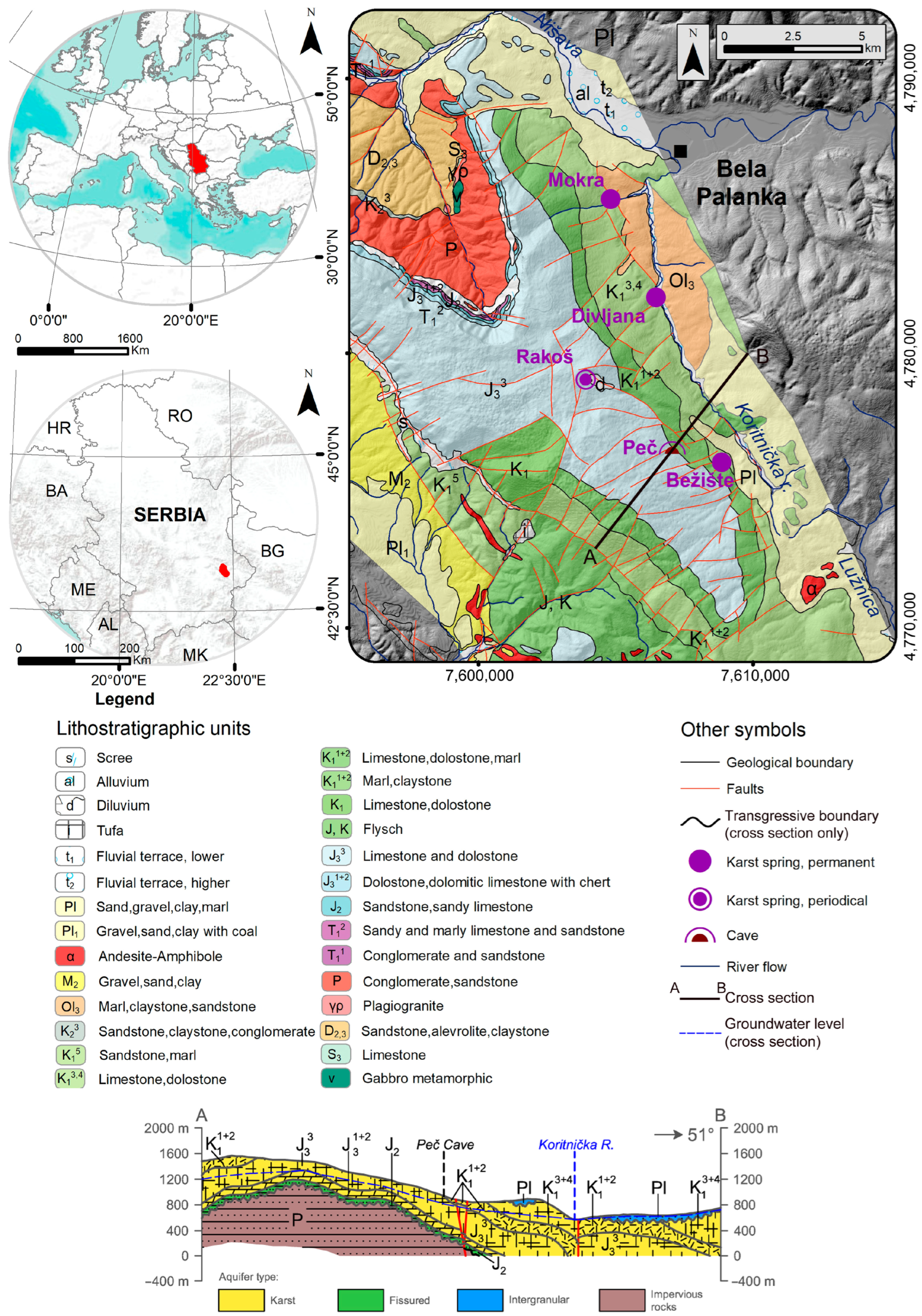
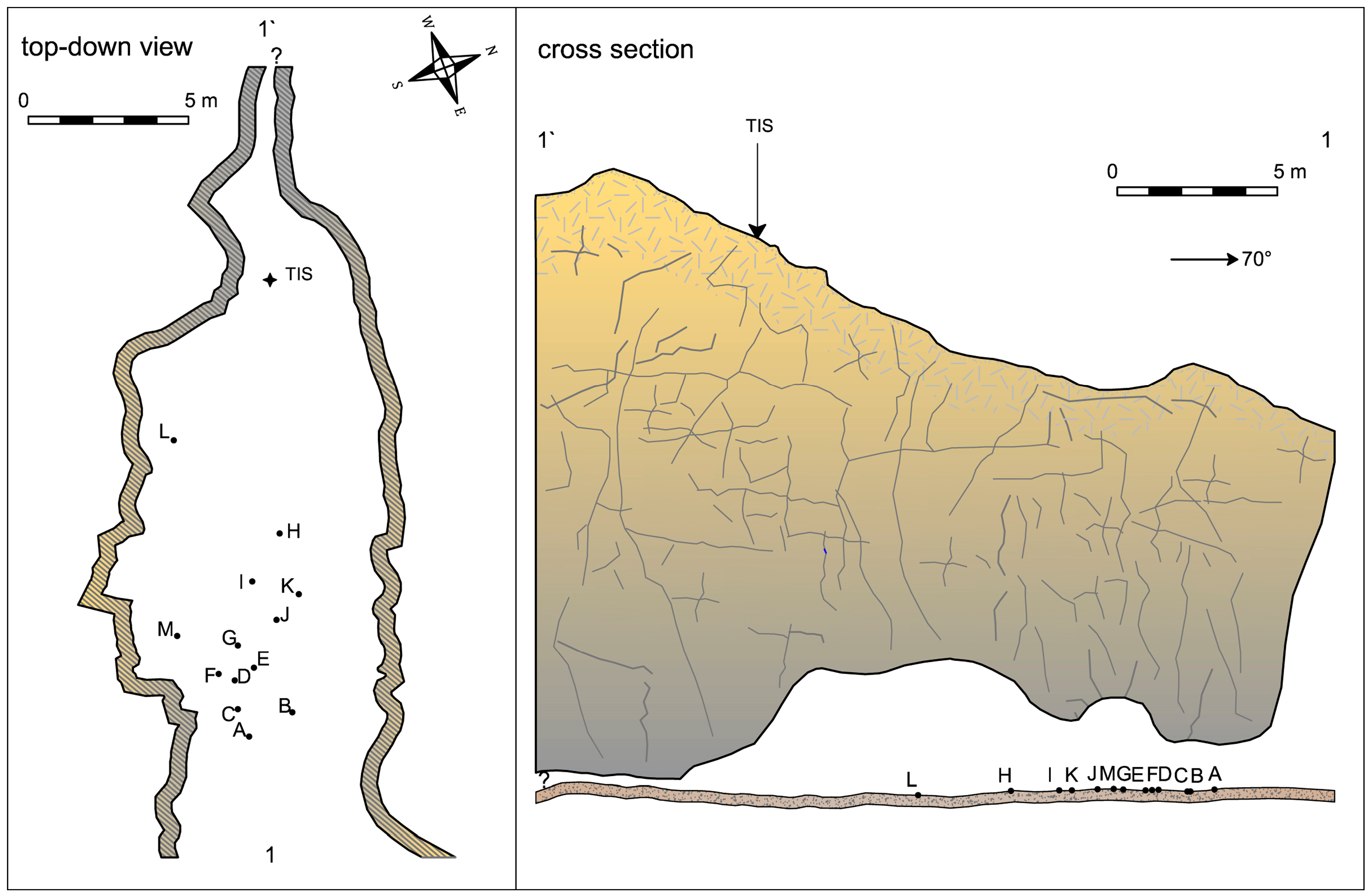
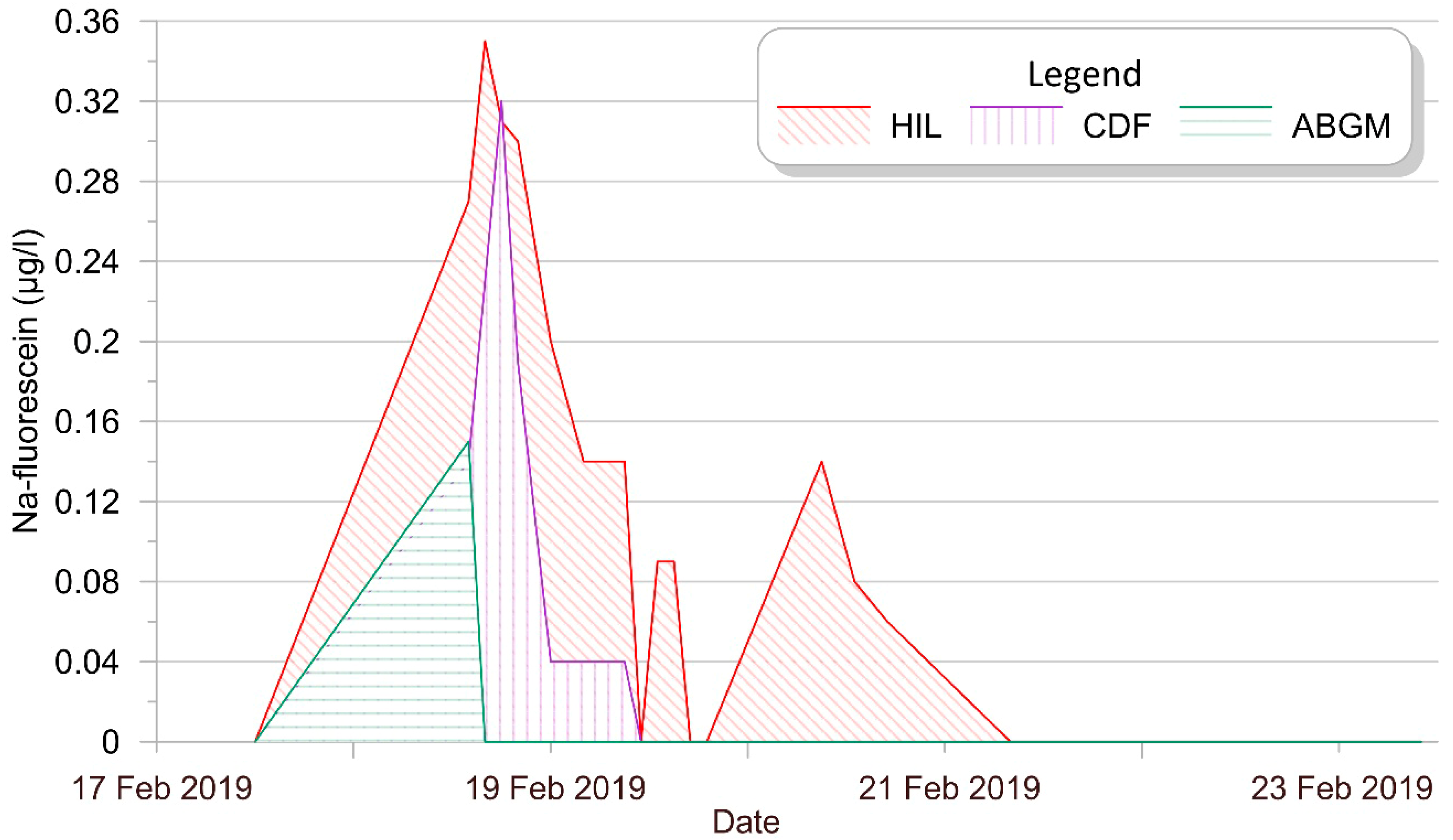

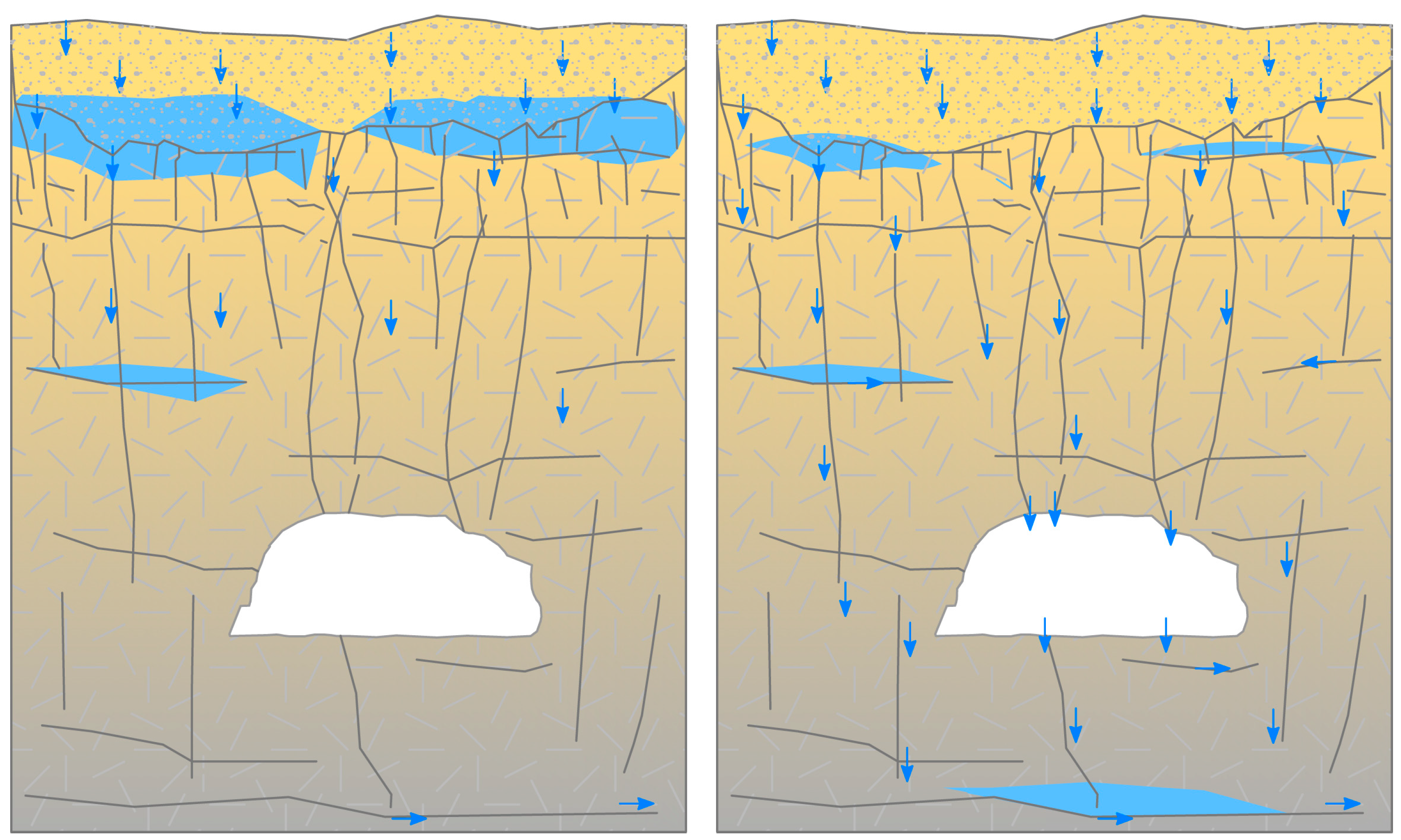
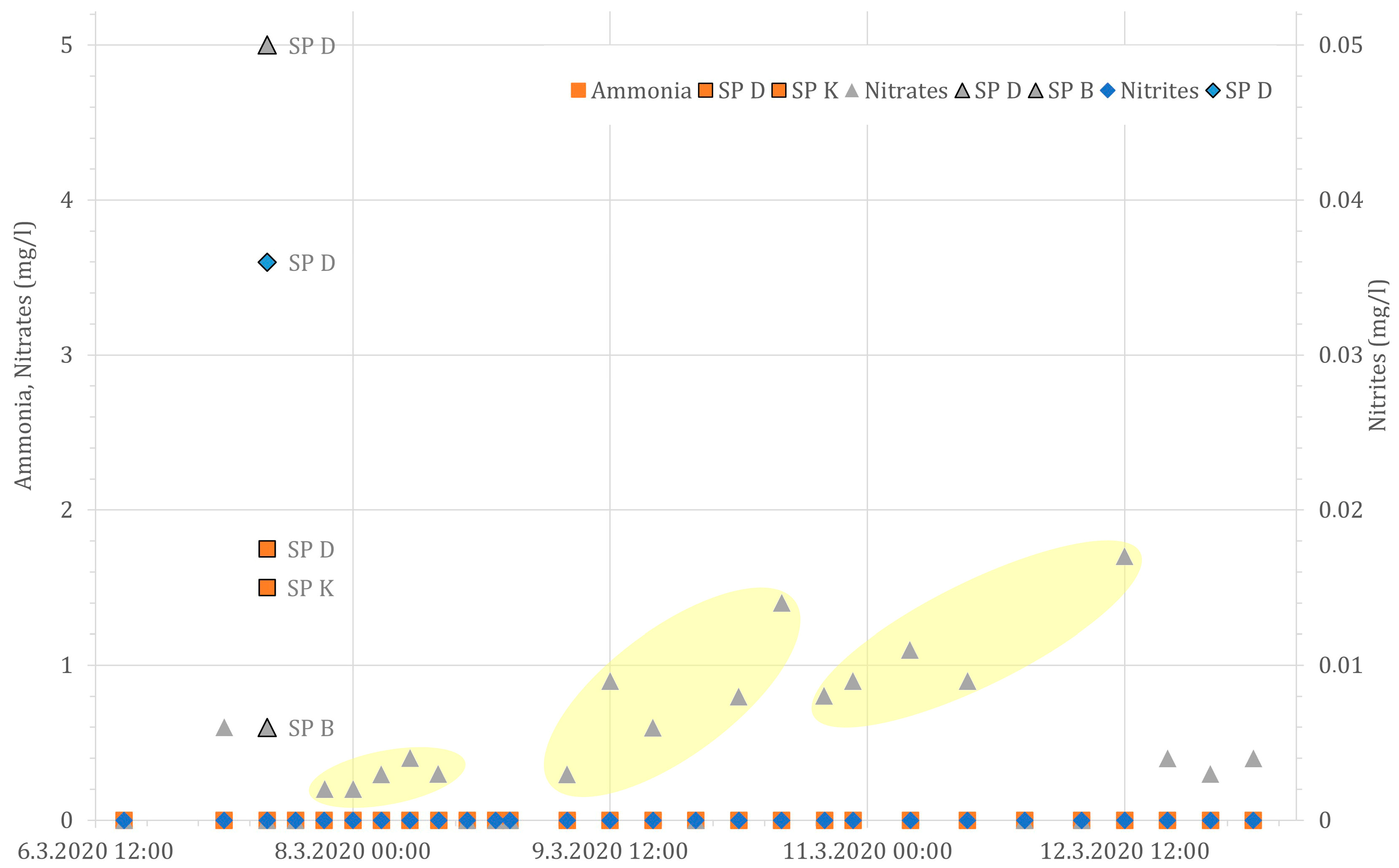

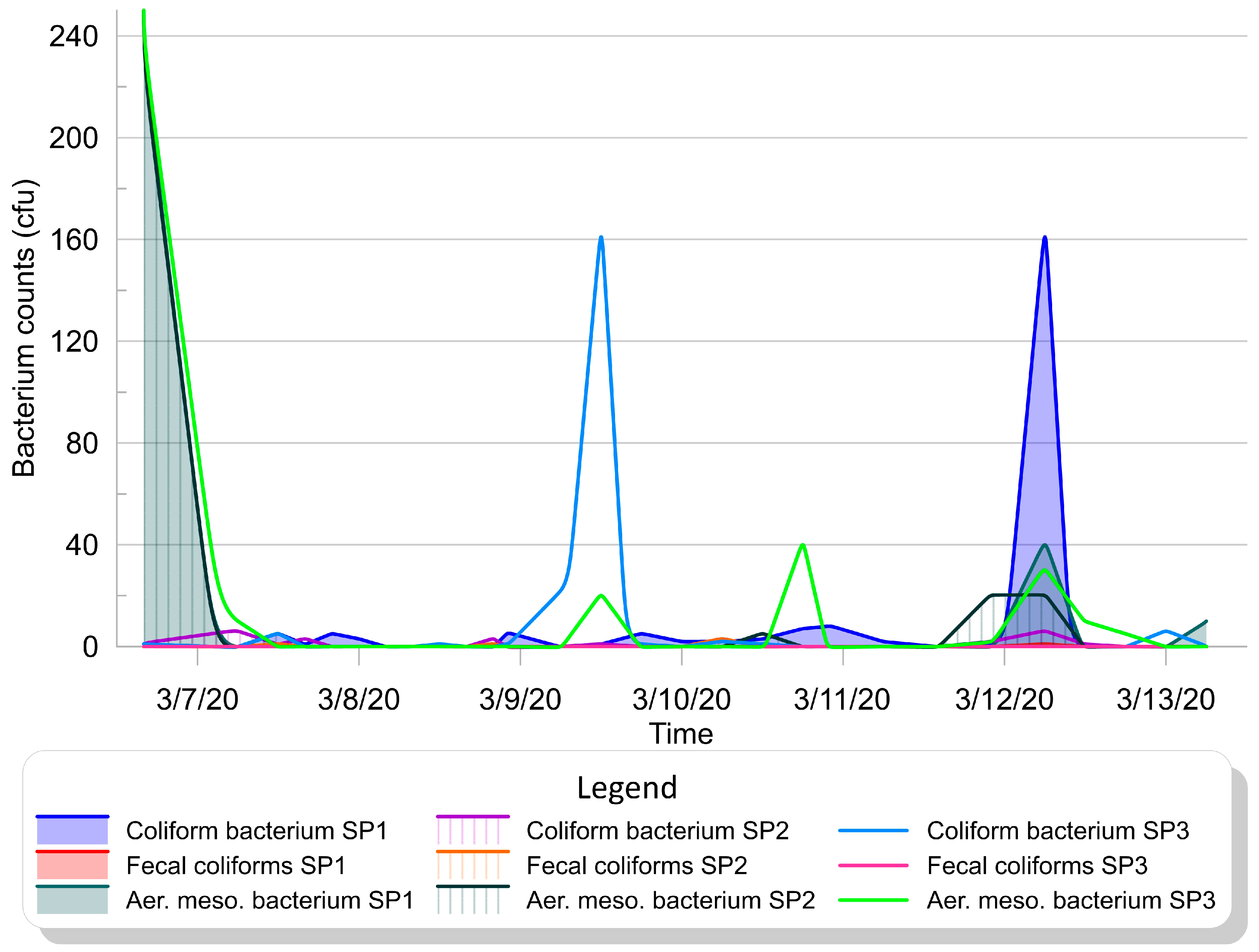
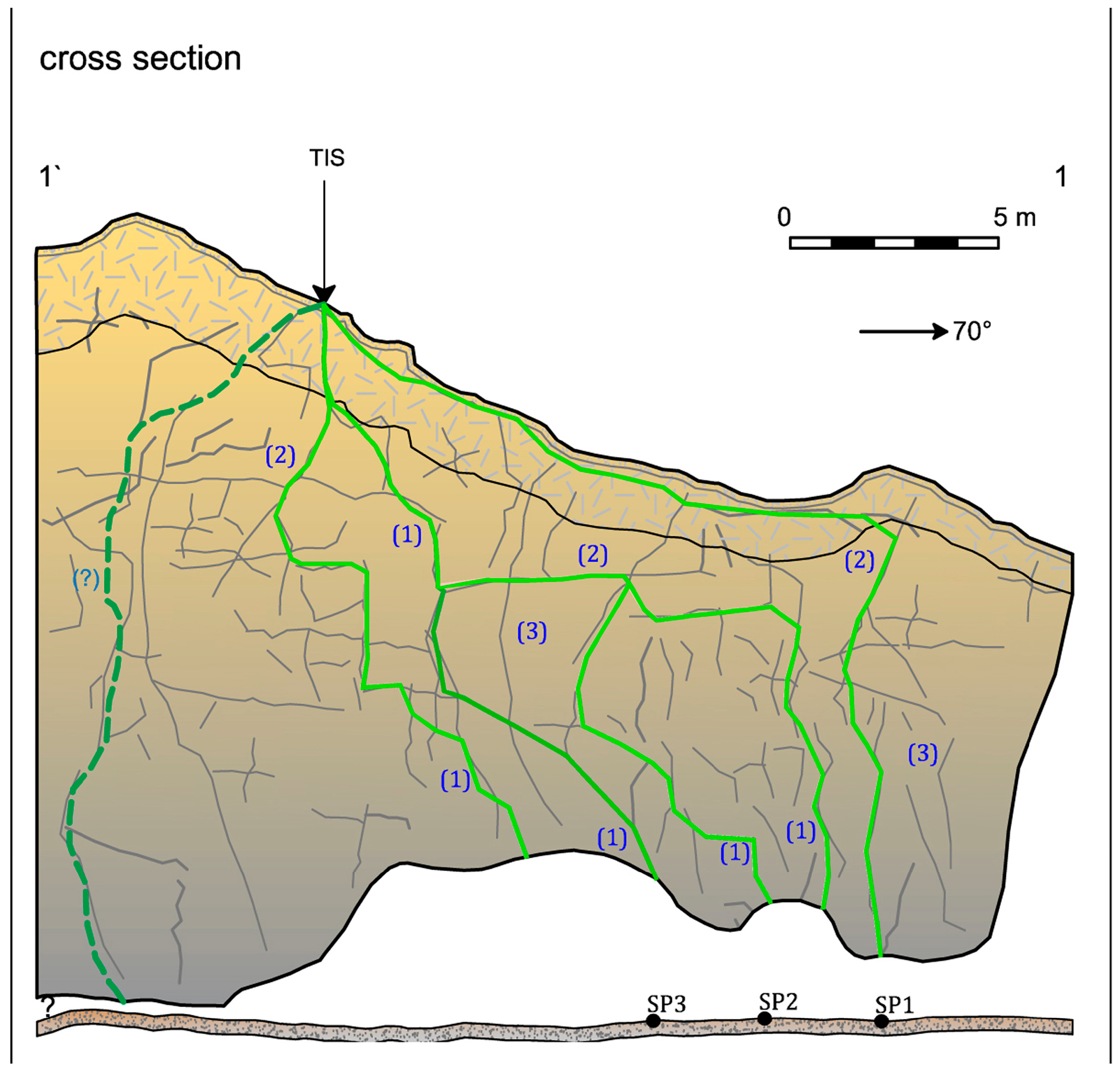
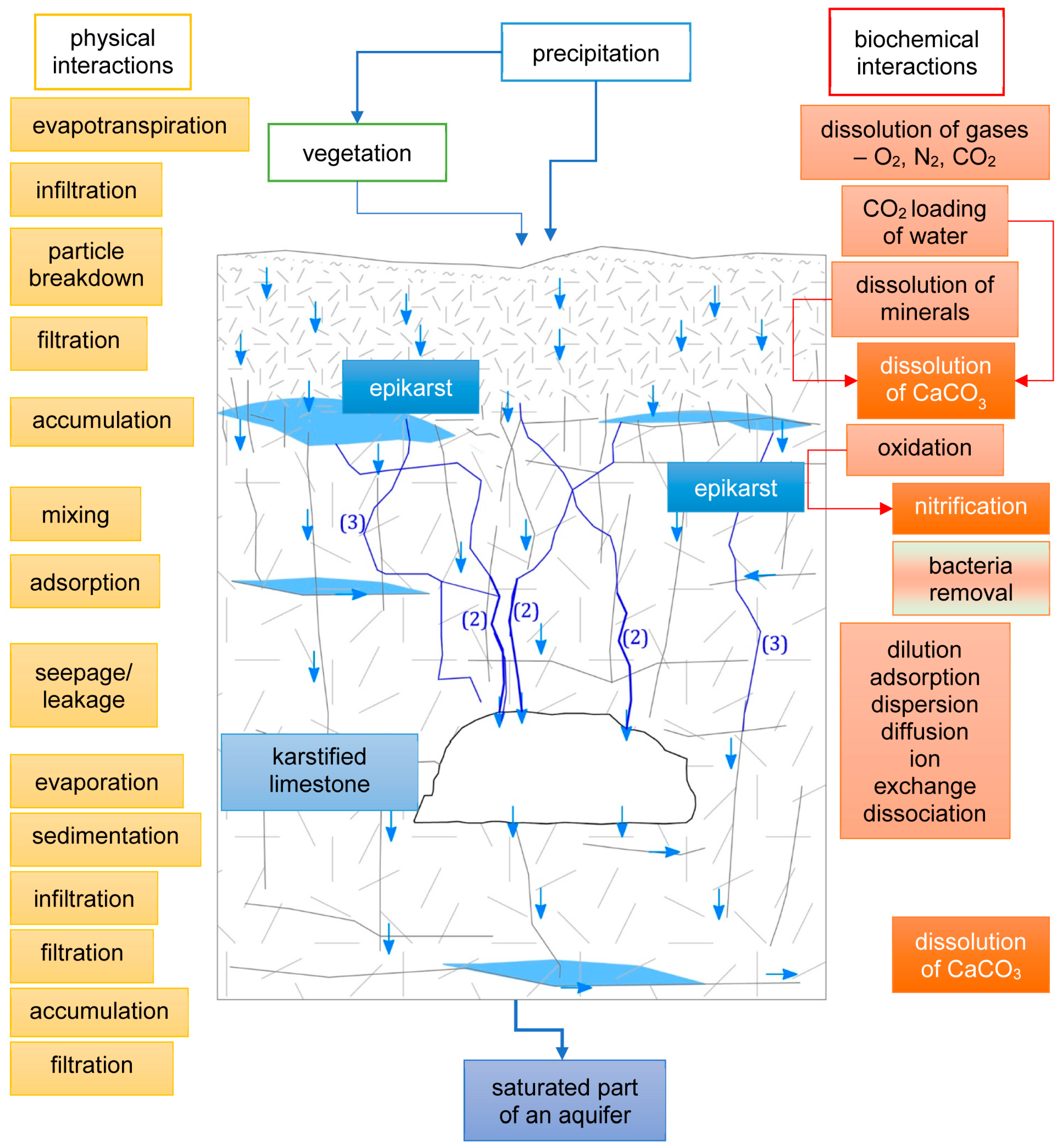
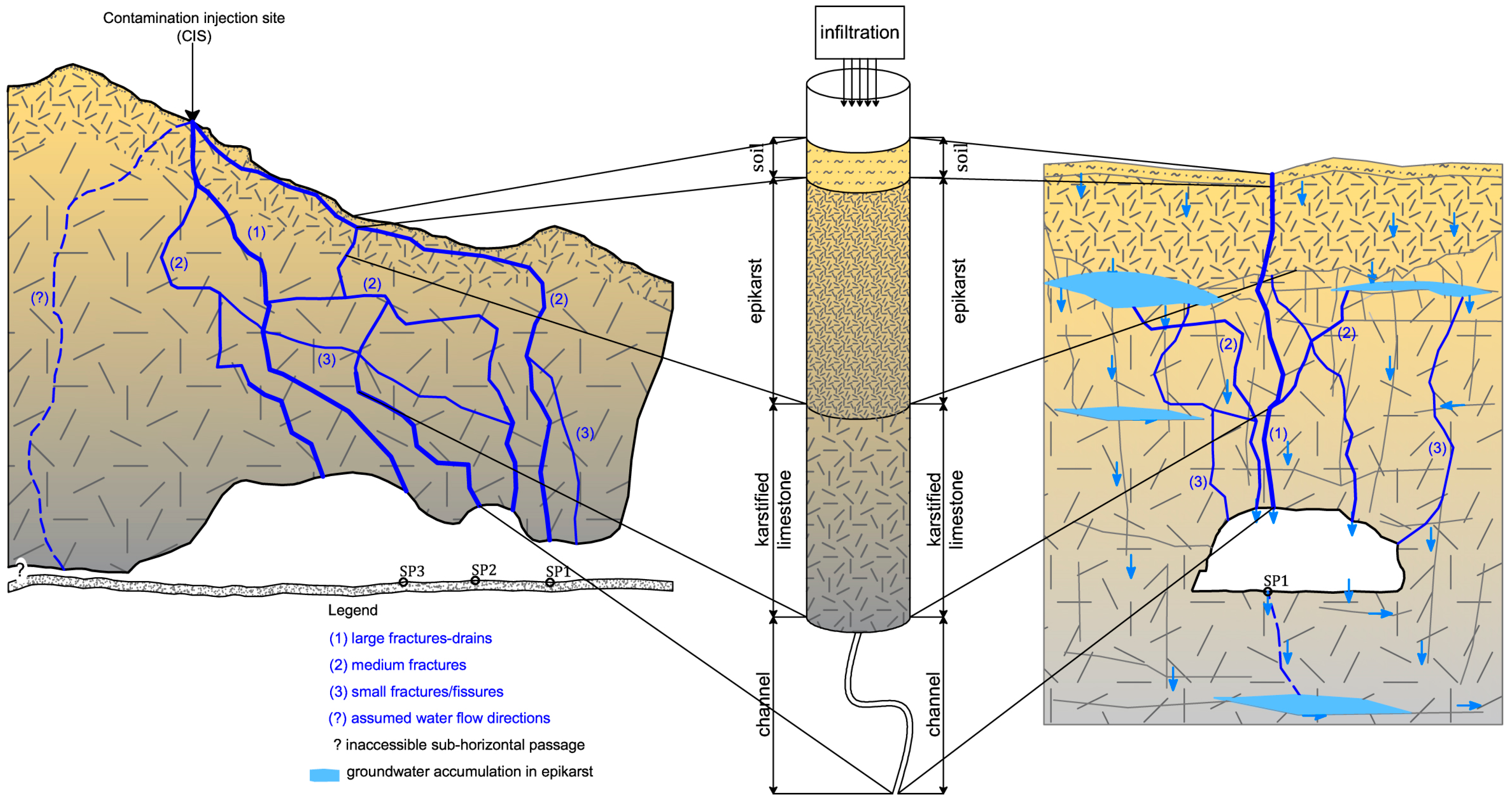
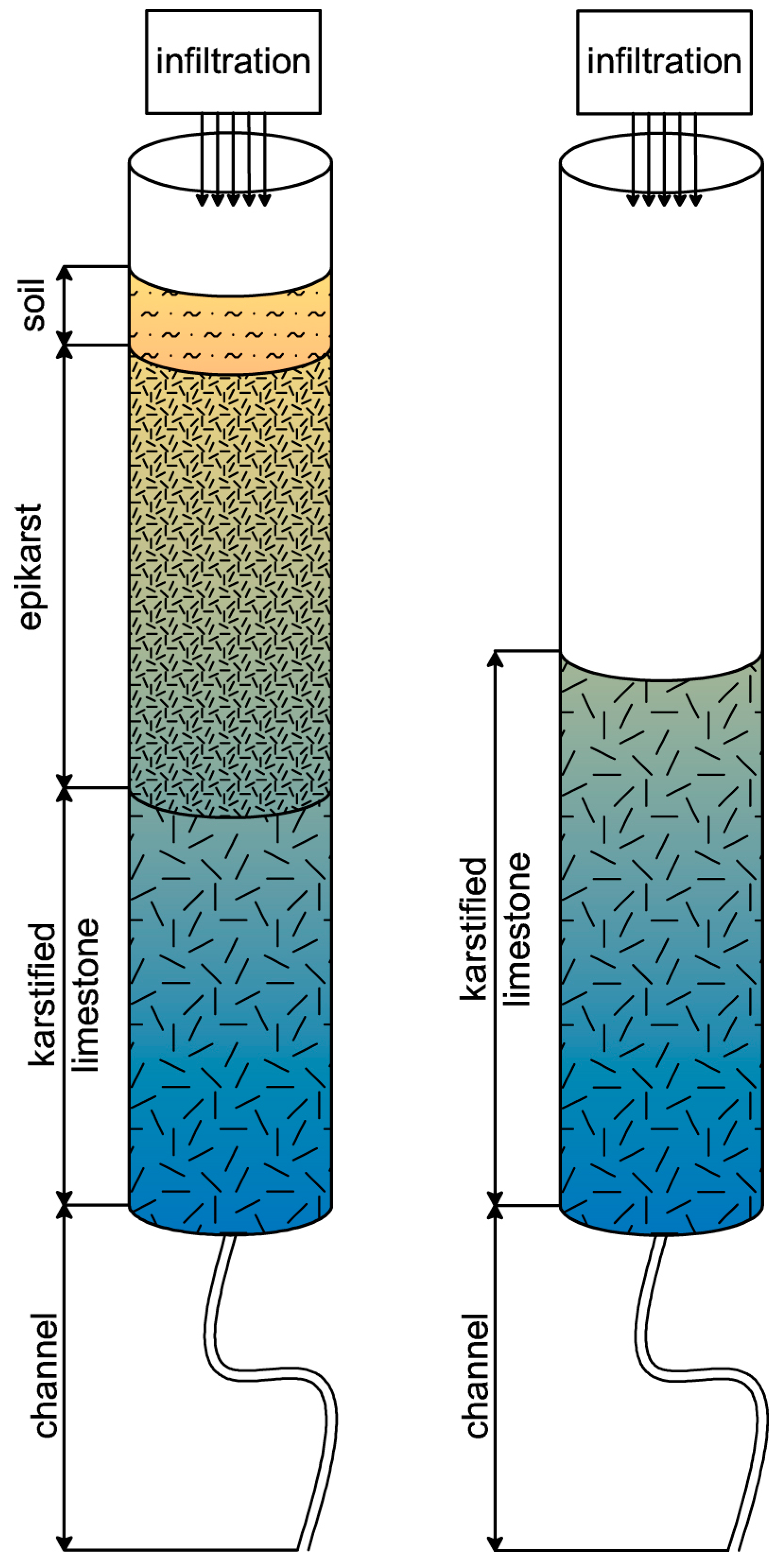
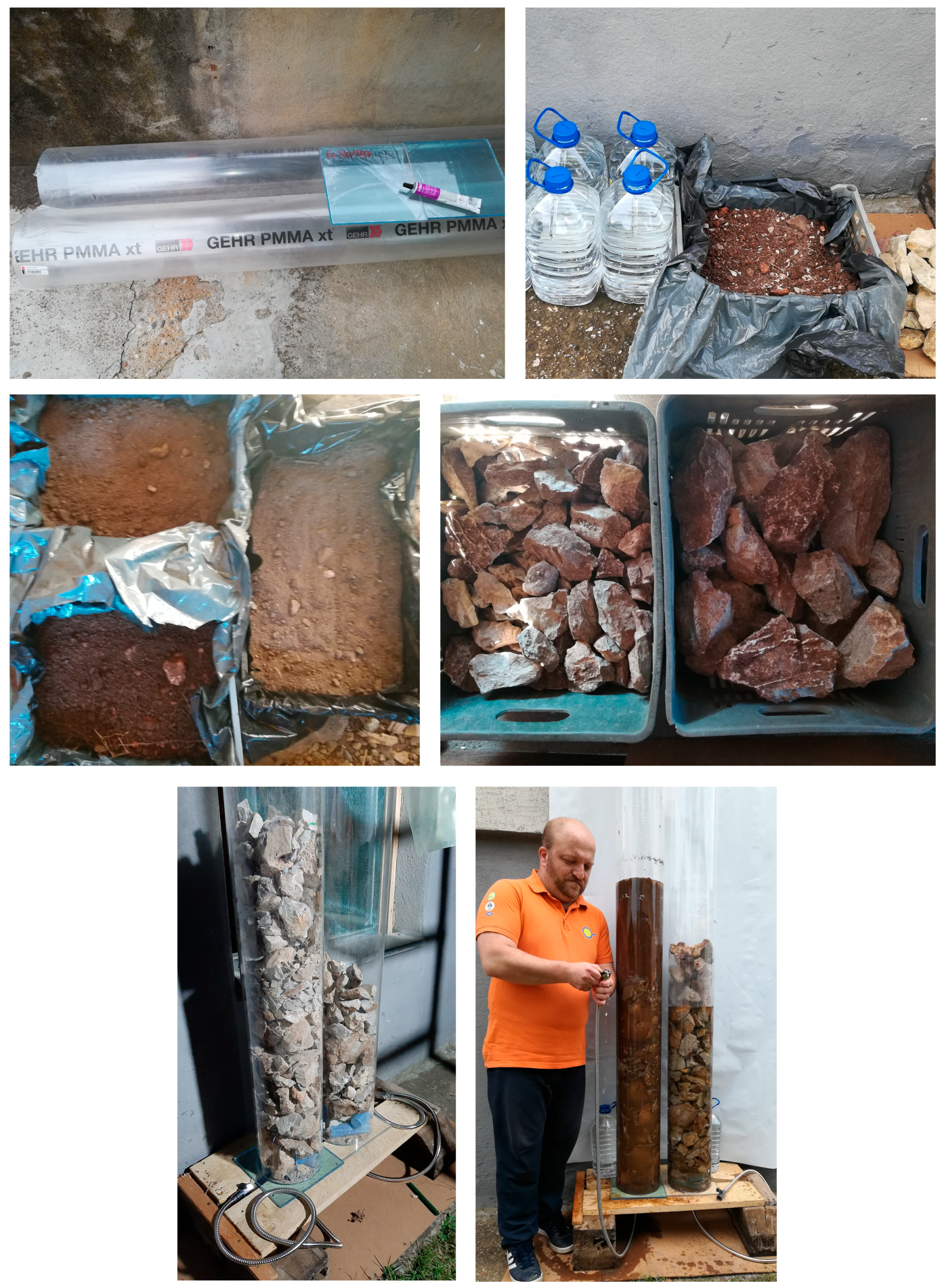
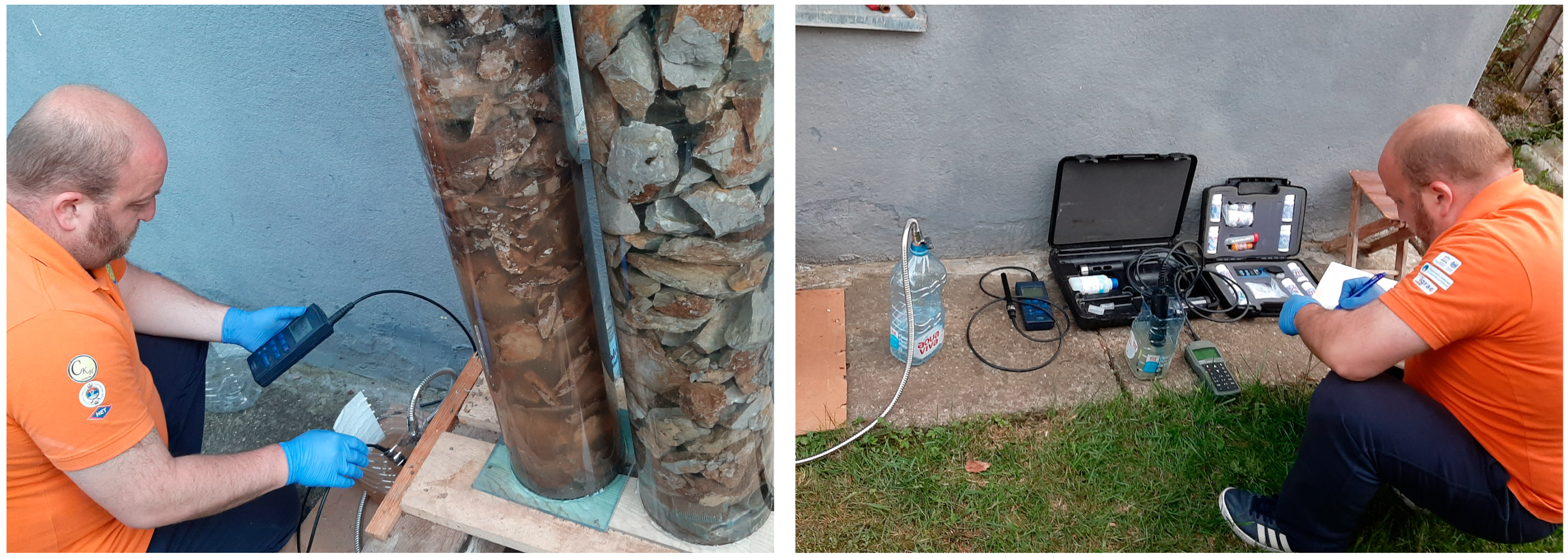

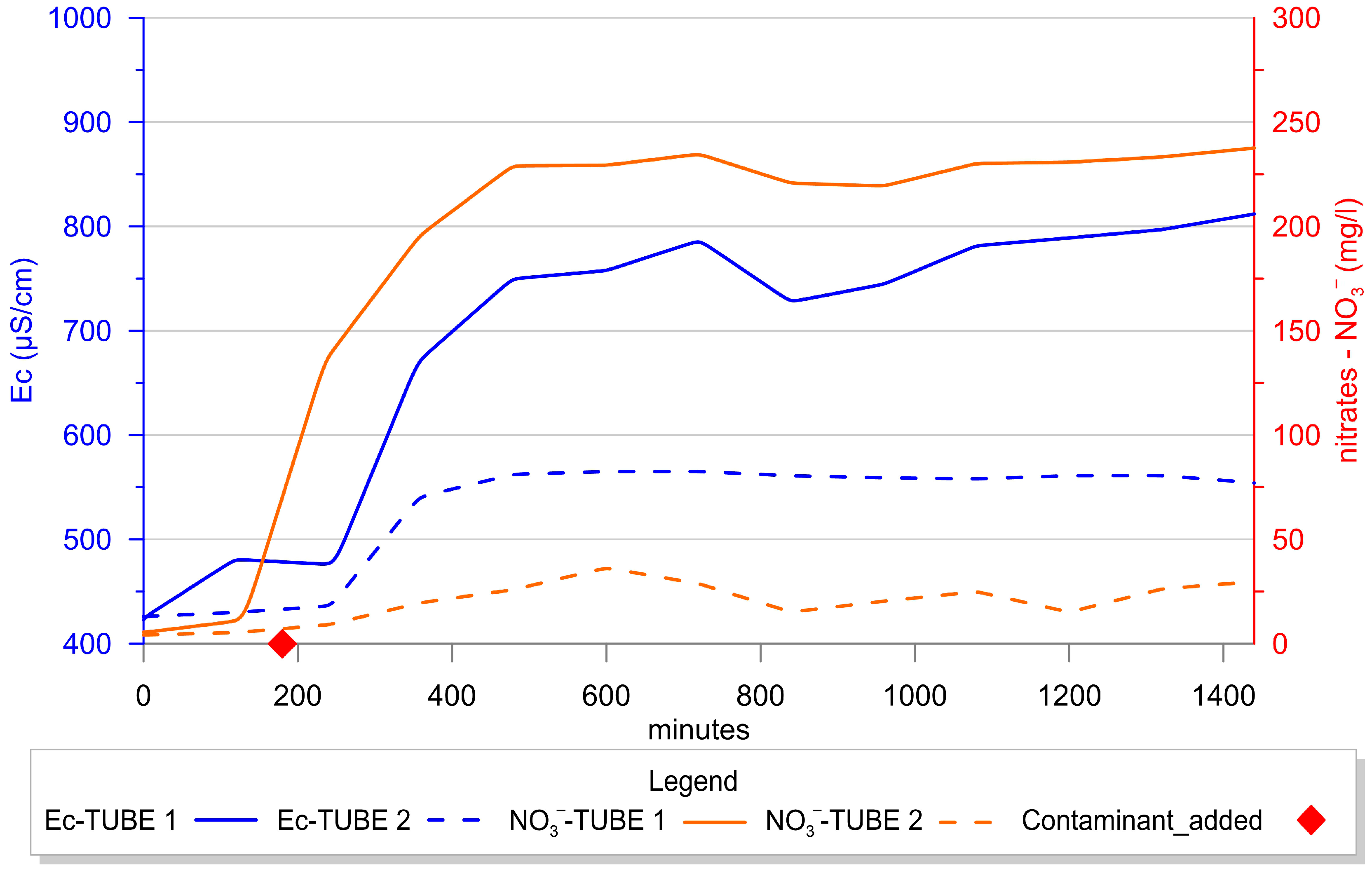
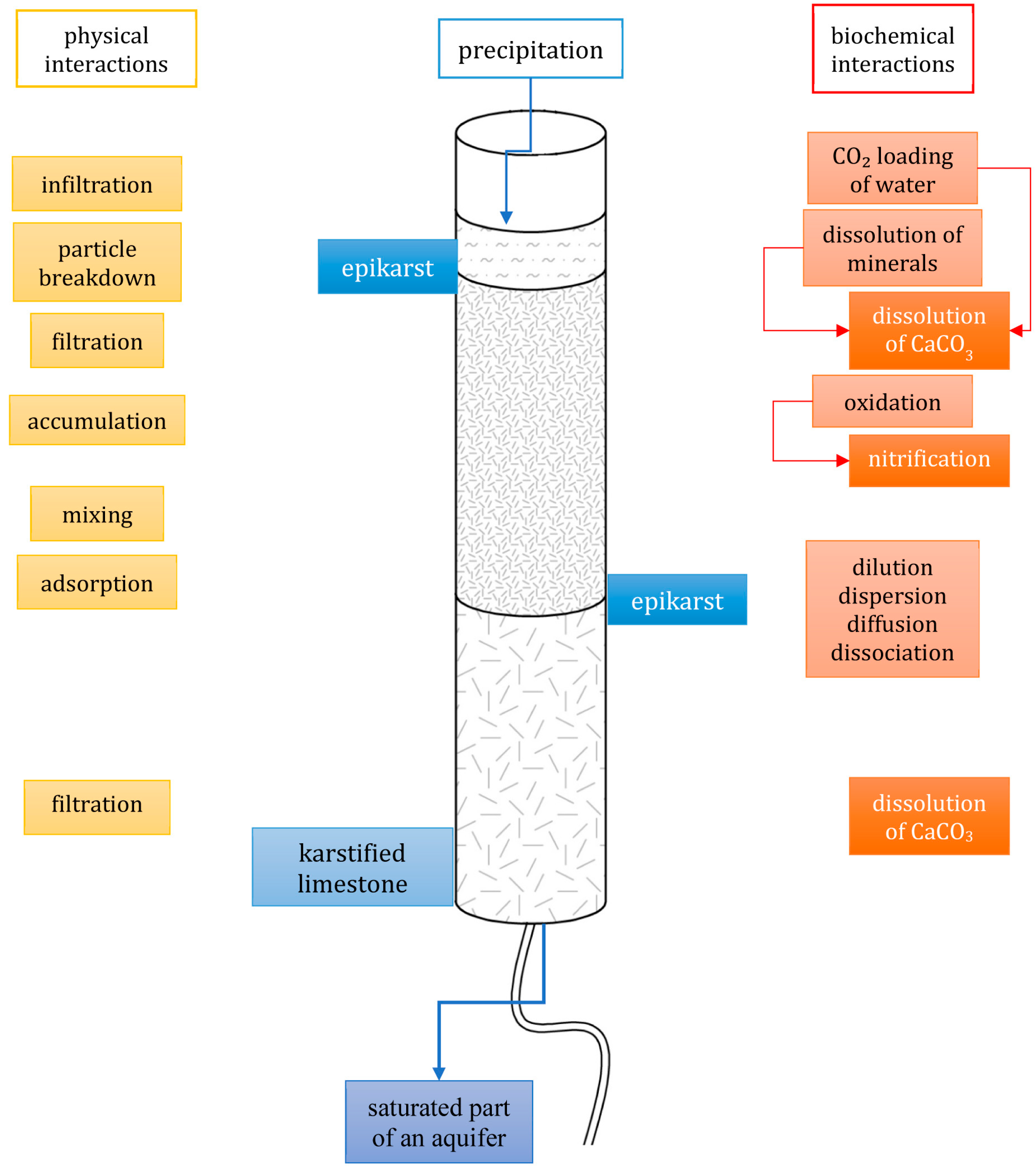
| Low-Intensity Contaminant | NH3 (mg/L) | NO2− (mg/L) | NO3− (mg/L) | Total Coliforms in 100 mL | Faecal Coliforms in 100 mL | Total Aerobic Mesophilic Bacteria at 37 °C/48 h, 1 mL | Faecal Streptococci in 100 mL MF | Proteus Species | Sulphite-Reducing Clostridia in 100 mL | Pseudomonas Aeruginosa in 100 mL |
|---|---|---|---|---|---|---|---|---|---|---|
| SP K | 1.5 | <0.005 | <0.17 | >161 | >161 | 0 | detected | 0 | 0 | 0 |
| SP D | 1.75 | 0.036 | 5 | 161 | 161 | >300 | detected | 0 | 15 | 0 |
| SP B | <0.05 | <0.005 | 0.6 | 5 | 0 | 5 | detected | 0 | 0 | 0 |
| Period | Cumulative Flow (L/h) |
|---|---|
| 6–7 March | 15–20 |
| 7–8 March | 25–30 |
| 8–9 March | 28–32 |
| 10 March | 30–34 |
| 11–12 March | 35–40 |
| 13 March | 15–20 |
| Ammonia (mg/L) | Nitrite (mg/L) | Nitrate (mg/L) | Coliforms and Faecal Coliforms (CFU/100 mL) | Faecal Streptococci (Yes/No) | Aerobic Mesophilic Bacteria (CFU/100 mL) | |
|---|---|---|---|---|---|---|
| SP K (slurry) | 1.5 | / | / | >161 | YES | / |
| SP D (groundwater) | 1.75 | 0.036 | 5 | 161 | YES | >300 |
Disclaimer/Publisher’s Note: The statements, opinions and data contained in all publications are solely those of the individual author(s) and contributor(s) and not of MDPI and/or the editor(s). MDPI and/or the editor(s) disclaim responsibility for any injury to people or property resulting from any ideas, methods, instructions or products referred to in the content. |
© 2025 by the authors. Licensee MDPI, Basel, Switzerland. This article is an open access article distributed under the terms and conditions of the Creative Commons Attribution (CC BY) license (https://creativecommons.org/licenses/by/4.0/).
Share and Cite
Petrović, B.; Vasić, L.; Milanović, S.; Marinović, V. Epikarst Flow Dynamics and Contaminant Attenuation: Field and Laboratory Insights from the Suva Planina Karst System. Hydrology 2025, 12, 276. https://doi.org/10.3390/hydrology12110276
Petrović B, Vasić L, Milanović S, Marinović V. Epikarst Flow Dynamics and Contaminant Attenuation: Field and Laboratory Insights from the Suva Planina Karst System. Hydrology. 2025; 12(11):276. https://doi.org/10.3390/hydrology12110276
Chicago/Turabian StylePetrović, Branislav, Ljiljana Vasić, Saša Milanović, and Veljko Marinović. 2025. "Epikarst Flow Dynamics and Contaminant Attenuation: Field and Laboratory Insights from the Suva Planina Karst System" Hydrology 12, no. 11: 276. https://doi.org/10.3390/hydrology12110276
APA StylePetrović, B., Vasić, L., Milanović, S., & Marinović, V. (2025). Epikarst Flow Dynamics and Contaminant Attenuation: Field and Laboratory Insights from the Suva Planina Karst System. Hydrology, 12(11), 276. https://doi.org/10.3390/hydrology12110276







